
Pinterest, edited in Postermywall"
TD sequential indicator can be defined as a quantitative(number) Indicator that is used by traders in the financial market to identify potential trends reversal positions. This indicator is used to identify trading areas, to buy or sell a financial asset.
The TD sequential indicator was name after the developer Tom Demark founder and CEO of the Demark Analytics, LLC. TD therefore stands for Tom Demark and that's why the Indicator is also called Demark Indicator in some places.
TD sequential indicator consist of 2 main concepts.
Set up( Buy and Sell Set-up) This concept can be broken down further into two, the Buy and Sell Setup. The buy and sell indicates a reversal in trend movement.
Countdown. The concept of the countdown indicates that momentum trend movement has completely been drained and a definite reversal is expected.
The TD sequential indicator is best used on the Japanese candlestick charts.
)
The TD sequential indicator is a rarely bused indicator but has proven to be a fairly good indicator.
As I earlier mentioned, the Indicator consist of two main concept, these are the concepts that traders use to determine a trend reversal or correction, and to identify entry and exit points in the market. The two concept earlier mentioned in the TD sequential indicator are the
- TD Setup
- TD countdown.
These two concept are used to identify trading opportunities in the market. I will explain
- TD Set Up. TD Setup is the first phase of the TD sequential. As I did earlier mentioned, the TD sequential is a number Indicator, so the TD Setup which is the first phase is made up of 9 counts(numbers).
The 9 count will give us a buy or sell opportunity based on the direction of Price. In a downtrend when prices are falling a TD buy Set-up is formed and conversely, a TD sell Set-up is occurs when we are in an uptrend. When the 9 count is complete in an uptrend or a downtrend, the a TD buy or sell set-up, a price or trend reversal is like to occur.
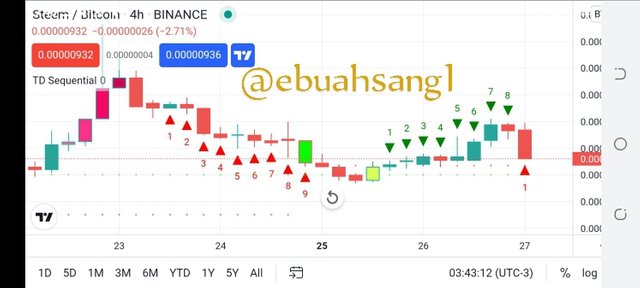
- TD countdown. The TD countdown is therefore the second phase that occurs after the first. As explained in the TD Setup, when the 9 count circle completes a reversal is likely to occur. However, if after the 9 count and yet the s no reversal, the TD countdown starts, which is a 13 count from the 9 count in the TD Setup. The TD countdown gives a more stronger and reliable reversal signal
)
As we already know, a Setup is a possible pattern reversal. We are going to explaining the bullish and bearish TD Setup but before we go any further, it is important to note that the TD sequential indicator works with the Japanese candlestick charts. The numbering or count of the TD is either placed at the top or bottom of a Candlestick
- TD Bullish Setup.
I did earlier mentioned that a setup is made up of 9 count. A Bullish Setup is same as TD buy Set-up. For a Bullish TD Setup to occur, the following criteria/recommendations are required.
- Downtrend. For a TD Bullish Setup, the market must be in a downtrend, with lower lows
- 8 or 9 counts. There must be 8 or 9 counts to complete the circle to call the setup ideal.
- The 9 count closes lower than the 4th count prior to it.
- Last but not the least, the low of the 8 or 9 Candlestick should be lower than or equal to the 6 or 7 Candlestick count.
When the above recommendations or criteria are met, we can say that a TD Bullish setup has occured and we are expecting price to pause or reverse and we can go ahead and buy the crypto pair.
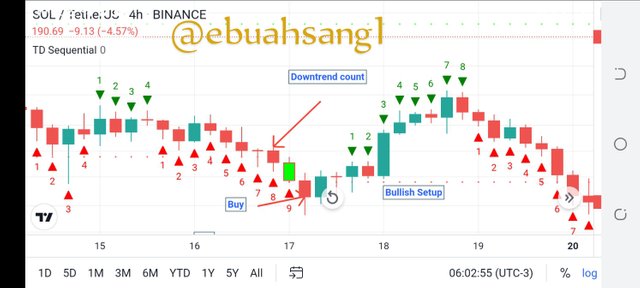
- TD Bearish Setup
Conversely to the TD Bullish Setup is a TD Bearish Setup. The TD Bearish Setup is also known as the TD sell Setup. For a successful TD Bearish Setup to occur, the following conditions or recommendations are required.
- The market or crypto currency pair prices should be in an uptrend.
- There must be 8 or 9 counts to complete the circle and call it an ideal setup.
- The 9 count should close higher than the 4 count prior to it.
- The high of the 8 or 9 Candlestick should be higher than or equal to the 6 or 7 Candlestick count.
When the above criteria has been met, we can say that a bearish TD Setup has occured and a trend reversal to a downtrend is expected. This is an ideal setup for a Sell position.
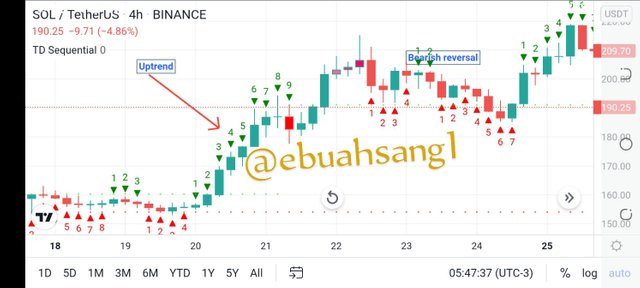
)
The most important aspect to successfully trade with the TD sequential indicator is to be able to identify Trend reversals using the Indicator.
We did mention earlier some key components that are required for the TD Setup to occur and also mentioned that the TD sequential usually have two phases, the setup and countdown. Now let's further the TD sequential conditions to graphical identify Trend reversals.
Perfect 9 or 8 count. To identify reversals using the TD sequential, let's remember the 9 count rule for a complete setup to occur. Now remember in a downtrend when the 8 or 9 count high(low) is greater than or equal to the 6 or 7 count high(low) we can say the perfect setup has occur.
So the first thing to identify a reversal is that the market should be a trending market. A ranging market will not give an ideal reversal. And in a trending market, successful 8 or 9 counts greater than or equal to a 6 or 7 count, then the reversal is much more sure to occur.
After the formation of the 9 count, we need gk check that the next count begins at one, this is a possible reversalsTimeframe of the Candlestick charts. It is ideal to put a higher timeframe for the Candlestick pattern when using TD sequential indicator. The higher timeframe has more probability of given more and accurate reversal signals
TD countdown. In a situation where the 9 count occurs and there is no reversal, we start the count all over from 1. Here we expect s countdown to 13 and not 9 as in the previous countdown. The 13 count is a definite proof that the trend is fading and the reversal might occur.
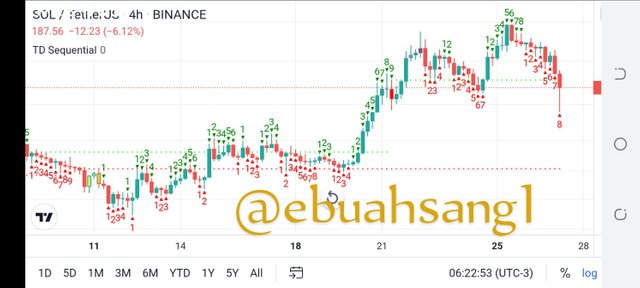
)
Buying BTCST/USDT
For the purpose of answering this question, I will do an analysis of the BTCST/USDT pair ok the Tradingview platform to identify the market count and know if it's a buy Setup or a sell Setup
TD sequential indicator and Stochastic oscillator indicator
I will be using the Stochastic oscillator indicator in synergy with the TD sequential indicator to analyze and determine a pattern reversal. As can be seen from the screenshot, the BTCST/USDT pair is in a downtrend meaning a bullish Setup and we earlier mentioned that during a bullish Setup, it is a buying position because we buy when prices are low and sell when they high.
Using the 4hours timeframe, I added first the TD sequential indicator to the price chart. Observation from the chart Indicator shows that we are on the 8 count and the rules of the eight count closing lower than the 6 count has been met.
Adding the Stochastic oscillator indicator to the chart, we can see that the k% line and D% lines on the Stochastic Indicator are below the 20% range. This is an indication of an overbought position.
Furthermore, drawing my support and resistance line, I could see that this price area of $39 has serve as an area of frequent support where price bounces and reverse. There are several support at this level when price bounces
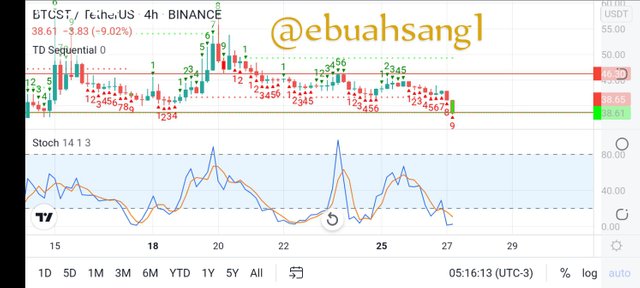
So a combination of the TD sequential indicator and the Stochastic Indicator with the ideology of support and resistance shows that the price of BTCST is about to reverse to an Uptrend. Due to this analysis, I decided to place a buy order of $12 at the market price using my Verified Binance account.

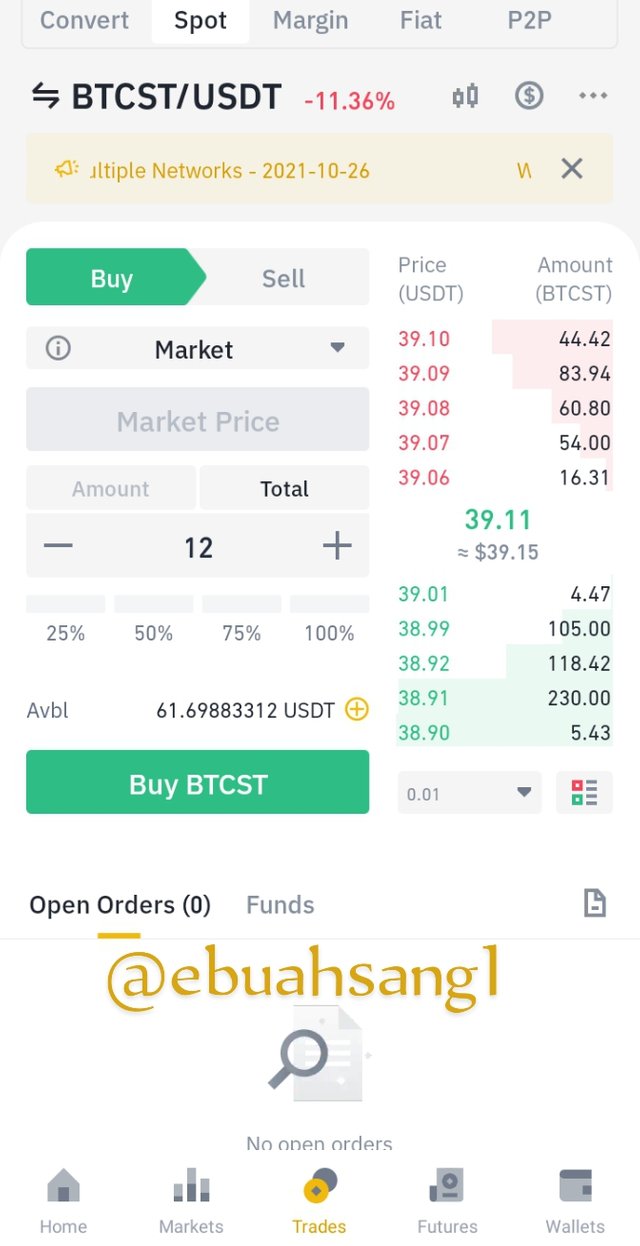
Selling BTCST/USDT
During my analysis, I place the support and resistance line. The resistance price is $45.5 and so I waited a few days for the price of BTCST to increase to the resistance price/level so I could sell it. Unfortunately, I waited for 4 days to execute my sell trade but unfortunately price dis not rise but reduced and stayed at the same level. So I had to sell at 38.3 taking a loss of about $1. See the image below
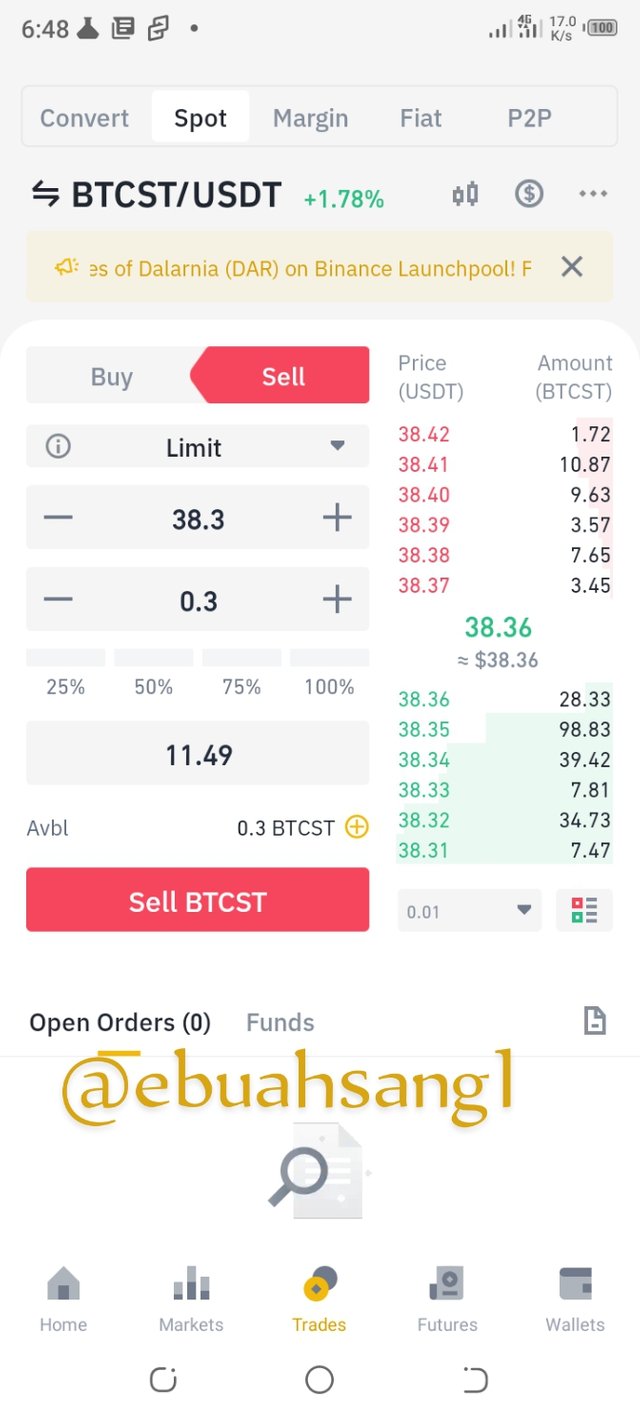
)
TD sequential indicator is a very important and somewhat reliable indicator. A good understanding of this Indicator will help traders to easily identify reversal positions or areas of correction.
As explained by Professor @reddileep, it is very important to understand the two phases of the TD sequential indicator although mostly the first phase id frequently used.
I wish to thank Professor @reddileep for an amazing explanation in the lesson for today. Thank you.